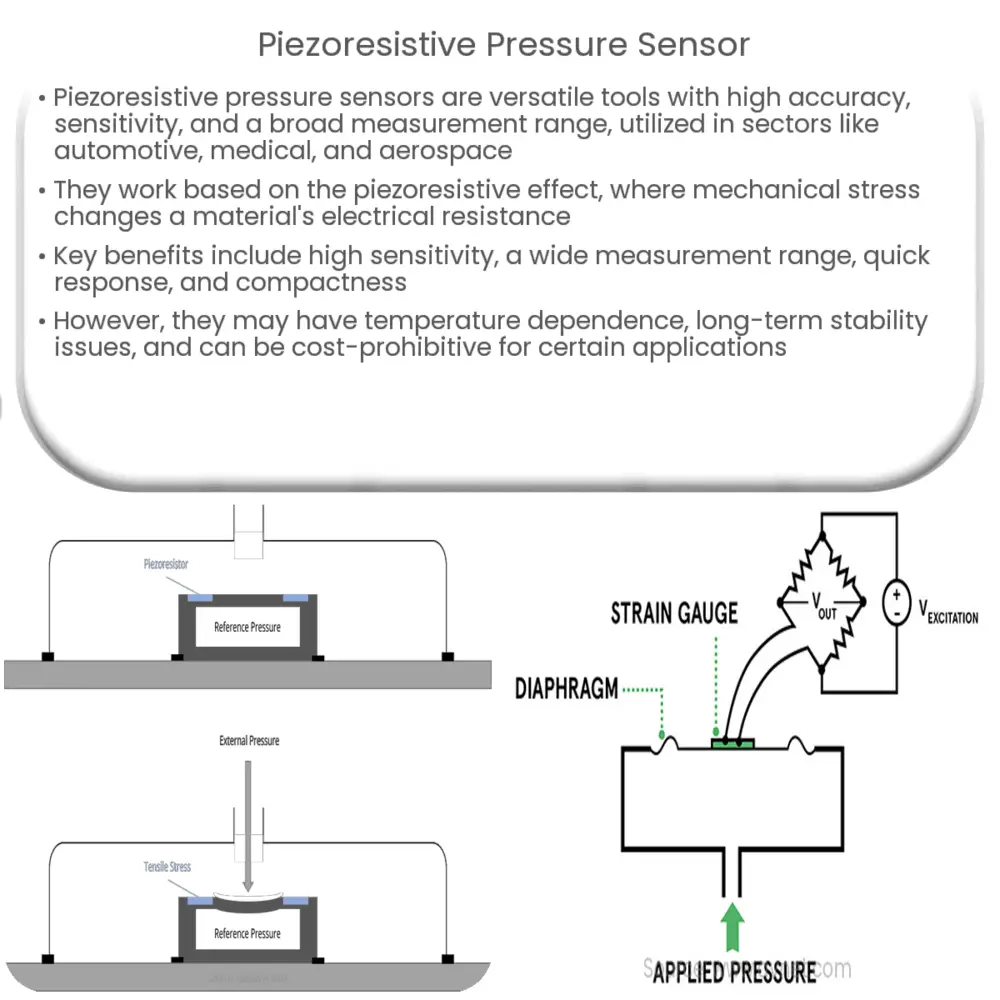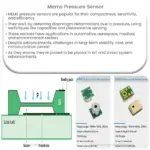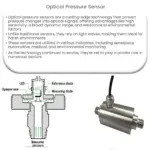Piezoresistive pressure sensors are highly sensitive devices used to measure pressure across various industries, offering accuracy and a wide measurement range.

Piezoresistive Pressure Sensors: An Overview
Introduction
Piezoresistive pressure sensors have emerged as a popular and versatile technology for measuring pressure in various applications. These sensors are known for their high accuracy, sensitivity, and wide measurement range, making them suitable for use in diverse fields such as automotive, medical, aerospace, and environmental monitoring. In this article, we will provide an overview of piezoresistive pressure sensors, exploring their working principle, advantages, and common applications.
Working Principle
The basic principle behind piezoresistive pressure sensors is the piezoresistive effect, which refers to the change in electrical resistance of a material when subjected to mechanical stress or strain. This phenomenon is observed in certain materials, such as silicon and germanium, which exhibit a change in resistance when deformed under pressure. The piezoresistive effect is typically quantified using a dimensionless parameter called the gauge factor (GF), which is defined as the ratio of the fractional change in resistance to the applied strain.
Piezoresistive pressure sensors consist of a diaphragm, which is a thin, flexible membrane that deflects under the influence of an applied pressure. The diaphragm is typically made of silicon or other suitable materials and is attached to a substrate. On the surface of the diaphragm, piezoresistive elements, or strain gauges, are arranged in a specific pattern, usually in the form of a Wheatstone bridge circuit. When pressure is applied to the diaphragm, it deforms, causing the strain gauges to experience mechanical stress. This stress leads to a change in the electrical resistance of the strain gauges, which is proportional to the applied pressure. The change in resistance can be measured and converted into an electrical signal that corresponds to the pressure being sensed.
Advantages of Piezoresistive Pressure Sensors
There are several advantages associated with piezoresistive pressure sensors, which contribute to their widespread use in various applications. Some of these advantages include:
- High sensitivity: Piezoresistive pressure sensors exhibit high sensitivity, allowing them to detect even minute changes in pressure. This makes them suitable for use in applications requiring precise pressure measurements.
- Wide measurement range: These sensors can measure a broad range of pressures, from very low to very high, making them suitable for a wide array of applications.
- Fast response time: Piezoresistive pressure sensors typically have a rapid response to pressure changes, allowing them to provide real-time measurements in dynamic environments.
- Compact and lightweight: Due to their small size and simple design, piezoresistive pressure sensors can be easily integrated into various systems, saving space and reducing the overall weight of the device.
Disadvantages of Piezoresistive Pressure Sensors
Despite their many advantages, piezoresistive pressure sensors also have some limitations that should be considered when selecting a pressure sensor for a specific application:
- Temperature dependence: The performance of piezoresistive pressure sensors can be affected by changes in temperature, which can lead to errors in the measurements. However, this issue can be mitigated by incorporating temperature compensation techniques into the sensor design.
- Long-term stability: These sensors may experience drift in their measurements over time, which can affect the accuracy of the readings. Regular calibration may be required to maintain optimal performance.
- Cost: While piezoresistive pressure sensors are generally more affordable than other types of pressure sensors, such as capacitive or optical sensors, the cost can still be a limiting factor for some applications, especially when high accuracy or long-term stability is required.
Common Applications of Piezoresistive Pressure Sensors
Piezoresistive pressure sensors are widely used in various industries and applications due to their versatility, sensitivity, and accuracy. Some of the most common applications include:
- Automotive: These sensors are often used in engine management systems to monitor fuel pressure, oil pressure, and tire pressure, as well as in safety systems like airbag deployment and brake systems.
- Medical: Piezoresistive pressure sensors are used in a range of medical devices, such as blood pressure monitors, ventilators, and infusion pumps, to ensure accurate pressure control and monitoring.
- Aerospace: In the aerospace industry, these sensors are utilized to measure altitude, cabin pressure, and fuel levels, as well as for monitoring hydraulic systems and engine performance.
- Environmental monitoring: Piezoresistive pressure sensors can be used to measure atmospheric pressure, water level, and depth, helping researchers and organizations monitor environmental conditions and detect changes in climate patterns.
- Industrial automation: These sensors are widely used in process control and monitoring systems to maintain optimal pressure levels in various industrial processes, such as manufacturing, chemical processing, and power generation.
Conclusion
Piezoresistive pressure sensors are a powerful and versatile technology that has found widespread use in numerous applications across diverse industries. Their high sensitivity, wide measurement range, and fast response time make them an attractive choice for many pressure sensing requirements. However, it is essential to consider the limitations and potential drawbacks of these sensors, such as temperature dependence and long-term stability, when selecting the most suitable pressure sensor for a specific application.




